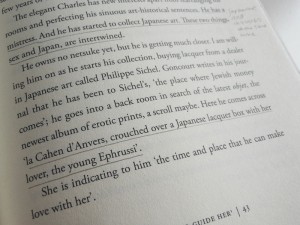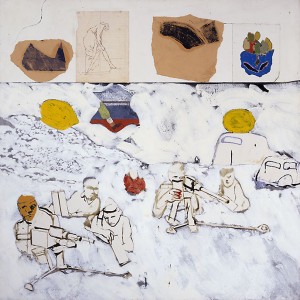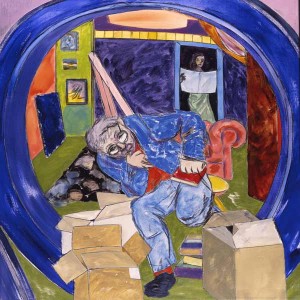An unexpected success in England and still climbing bestseller rungs all over the world, The Hare with the Amber Eyes by Edmund de Waal is an exhibition in book form. The author, a potter, tells the history of his Jewish banking family, the Ephrussis, via the artifacts it collected, cared for, and bequeathed. 
The objects gain meaning via detailed descriptions. Who acquired them, at which time, for what purpose? What do they say about their buyer’s character, heritage, and destiny? Among the artifacts is the title-giving “Hare with Amber Eyes,” one of 264 Japanese netsuke wood and ivory carvings, which changes hands many times. → continue reading

R.B. Kitaj, Kennst Du das Land?, 1962 © R.B. Kitaj Estate
A few years ago during a summer spent in Catalonia, I strolled through the port city of Sant Feliu de Guíxols. It is a special place: it was spared the transgressions of the Spanish coast’s building mania due to its fishing industry. It is not merely decorative but in fact successful in a particular industrial branch: producing cork. And here – nominally part of Spain but somehow a place all of its own – R.B. Kitaj and his wife spent the winter of 1953/54. Twenty years later, he bought a house in this town. What did it mean to him, this stubborn region that again and again rebelled against Spanish supremacy? → continue reading
Kitaj once said that books are for him what trees are for a landscape painter. His ateliers in the London neighborhood of Chelsea and in Westwood, Los Angeles, were crammed full of books, on shelves, around his easels and piled up on the floor.

R.B. Kitaj, Unpacking my Library, 1990-1991 © R. B. Kitaj Estate
He was already ranging through the cheap bookshops on 4th Avenue – the largest bookselling district in the world – on his way to Cooper Union when he was a student there. He found the modern classics like James Joyce, Ezra Pound, T.S. Eliot, and Kafka, as well as journals such as the “Partisan Review” and the American surrealist magazine “View.” In Oxford, his teacher Edgar Wind introduced him to the Warburg School and he bought a complete set of the famous “Journals of the Warburg Institute.” His visual imagination was fuelled by the illustrations for the “Afterlife of Antiquity,” copperplate engravings made according to ancient templates. In 1969, Kitaj published as silkscreens 50 book jackets from his personal library, in an edition that he called “In Our Time: Covers for a Small Library after the Life for the Most Part.” → continue reading


